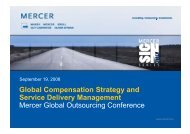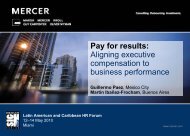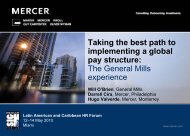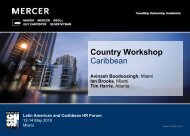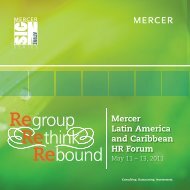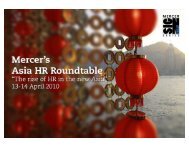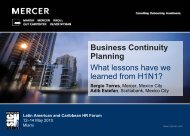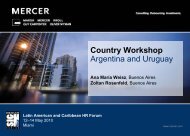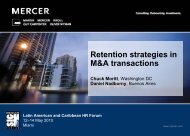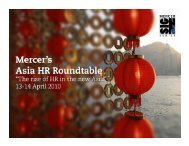A SERIES OF ARTICLES FRoM THE 2011 EMEA CoMPENSATIoN ...
A SERIES OF ARTICLES FRoM THE 2011 EMEA CoMPENSATIoN ...
A SERIES OF ARTICLES FRoM THE 2011 EMEA CoMPENSATIoN ...
You also want an ePaper? Increase the reach of your titles
YUMPU automatically turns print PDFs into web optimized ePapers that Google loves.
OPTIMISING HUMAN CAPITAL INVESTMENTS:<br />
ANALYSIS-BASED INSIGHTS TO ADDRESS IMPERATIVES FOR<br />
CHANGE AT OECD<br />
There has been a clear evolution over the past few years in<br />
how organisations inform their human capital decisions.<br />
They have been shifting focus from the use of market data<br />
in benchmarking pay “rates” and practices to the analysis<br />
of robust, organisation-level data maintained in the human<br />
resources information system (HRIS) and supporting<br />
systems in order to understand the drivers of key workforce<br />
outcomes. Through application of statistical models to such<br />
data, organisations can obtain strategic insights on human<br />
capital priorities. The objectives of such workforce analytics<br />
are to refine people strategy and to optimise organisational<br />
performance.<br />
ABOUT <strong>THE</strong> OECD<br />
The Organisation for Economic Co-operation and<br />
Development (OECD) is “an international public<br />
organisation” financed and governed by its 34 member<br />
countries. Its primary activities are to provide research<br />
and advice on social policies, and its workforce consists<br />
largely of economists, statisticians and specialised<br />
policy analysts. Its structure mirrors the national<br />
administrations it represents: it has 2,800 staff, half in<br />
professional and half in support roles. Located in Paris,<br />
its employees are, in principle, recruited from member<br />
nationals. Around 35% of its employees are French,<br />
11% British and 9% American.<br />
<strong>THE</strong> ENVIRONMENT AND IMPLICATIONS FOR<br />
<strong>THE</strong> OECD<br />
Significant macroeconomic and social changes are<br />
now calling for the reform of HR policies and practices.<br />
A primary change is the shift in global economic power,<br />
reflected in the expansion of the old G7 – the “club of<br />
rich countries” – into the G20. Interests of the member<br />
countries have broadened. Also, the funding model<br />
has become more unpredictable. Today, governments<br />
are much more demanding and an increasing amount<br />
of funding comes with specific projects attached – and<br />
it can be difficult to anticipate what those projects<br />
might be. The main policy work of the OECD has<br />
become, necessarily, more multidisciplinary, which<br />
means that the organisation has to work in a more<br />
holistic and integrated manner than it has in the past.<br />
Adapting to these changes carries implications for the<br />
organisation’s human capital strategy. Essentially, it<br />
needs to complement its specialists with generalists,<br />
those with a broader perspective; it has to use its<br />
financial and human resources more effectively to<br />
meet changing needs; and it needs to act in a more<br />
coherent fashion in its human capital management<br />
rather than in a decentralised manner. The HR team<br />
moved to address these imperatives through an<br />
analytic assessment designed to find out how people<br />
were moving up, through and around the organisation;<br />
what kinds of movements led to success and might<br />
be exploited to generate the right kind of expertise;<br />
and how the organisation could capitalise on that<br />
knowledge to meet the challenges ahead. Given the<br />
organisation’s analytic “product” and highly technical<br />
leadership, an analytic approach would make the most<br />
effective business case for change.<br />
20




